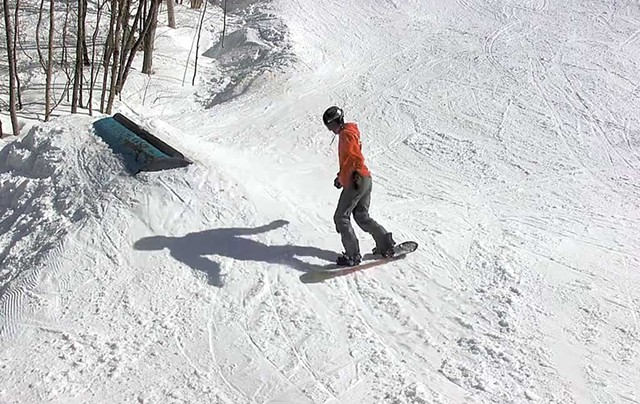
- Courtesy
- Image capture of Noah Bousquet at Bolton Valley Resort
When former pro snowboarder Adam Hostetter was training for the 1998 Winter Olympics in Nagano, Japan, his team's coaches were among the best in the world. Yet those trainers often spent much of their time on something seemingly unrelated to snowboarding — holding a video camera.
Typically, one coach would stand on the mountain and film each athlete coming down the course, then immediately turn around to catch the next one leaving the gate. The coach might capture, at best, 50 percent of an athlete's run — and often much less, Hostetter noted, especially if he couldn't see the entire course from his position on the slopes.
"Not only is the coach focused on filming and not coaching, but rarely do they get every run," he added. "Then, at the end of the day, they'd have to download that footage from the camera or upload it to the web."
Hostetter, 48, has long since retired from competitive snowboarding. But several years ago, when his kids started training as ski racers at Burke Mountain Academy in East Burke, the businessman saw an opportunity to improve their competitive edge. "I realized that the filming and analyzing of video is as cumbersome today as it was 25 years ago," he said.
So four years ago, he launched Capture Video Technology, a Stowe-based startup that mounts automated cameras along ski slopes, terrain parks and mountain bike trails that can record competitors' runs, then uses its own proprietary software to instantly stitch the footage together. The technology could soon become a powerful training tool for competitive athletes and their instructors.
And in an era when young skiers and snowboarders like to record their jumps and stunts on the mountain, then post the videos on social media, Capture Video Technology could make that process faster, easier and more efficient. In doing so, it would also enable skiers and riders to focus on what they actually came to the mountain to do: enjoy the pow.
But Capture Video Technology, which now has half a dozen employees, must be careful not to get out over its skis. The company still needs to woo resort owners, ski schools, and professional coaches and instructors by convincing them that its technology justifies an investment in the recording equipment and maintenance fees. To do so, it also needs to convince skiers and snowboarders, many of whom already record themselves with smartphones, GoPro cameras and drones, to switch to Capture's fixed, ground-based cameras.
Here's how Capture Video Technology works: The company has developed a free, downloadable iOS app, called Capture Sports, that uses the iPhone's built-in GPS technology. (Android users can access Capture's technology using the GPS-enabled Strava exercise-tracking app.)
When skiers and snowboarders go to a resort, race or mountain event that's equipped with Capture Video Technology's equipment, they simply press start on the app, tuck the phone into a pocket and begin their run.
As the skier or rider crosses into a GPS-designated "capture zone" along the slope, the camera in that zone automatically identifies the user and starts recording. Each time the rider enters a new capture zone, the app triggers the next camera to start filming.
At the bottom of the hill, the user hits stop on the app. About 90 seconds later, the footage, which has been automatically edited into one seamless video, can be accessed and downloaded. In effect, the skier or snowboarder can watch their last run even before they board the chairlift for the next one.
Hostetter said he initially envisioned that the technology would be used only by elite athletes but soon realized it would also appeal to more casual skiers and snowboarders.
"We've had hundreds of people download our app and use it," Hostetter said. "A lot of them are super excited about the fact that everyone can go through and hit the jumps."
Noah Bousquet of Essex Center was one of them. The 15-year-old snowboard racer first tried the Capture Sports app in March during the Blauvelt's Banks snowboarding fundraiser race at Bolton Valley Resort. Although the video wasn't recorded in high resolution — and Bousquet said he would have preferred a vertical image, which is consistent with how most Instagram and TikTok videos are shot — "it was definitely cool," he said.
"I didn't have to take out my phone and record. It just happened," he added. "And you don't have to always rely on someone else filming you."
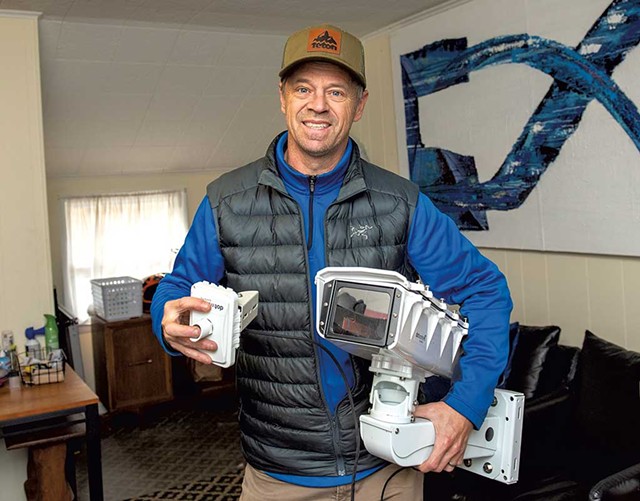
- Kevin Goddard
- Adam Hostetter with a Capture Video Technology camera
Indeed, that's a major selling point of the technology, Hostetter explained. Normally, whenever skiers and snowboarders want to film themselves on the slopes or in a terrain park, one member of their group must agree to "take one for the team," sit out that run and record their friends doing their best moves.
But all too often, the video quality isn't great. The shooter's hands get cold and shaky. The videographer misses the jump, the trick or the landing. The battery dies, the camera gets snow or ice on it, or the lens fogs up. And if it's a GoPro camera, Hostetter added, it only records what the skier or rider sees, not what they do.
None of those concerns applies to Capture Video Technology, Hostetter explained. All of its videos are stable, consistent, in focus and shot from the same vantage point every time. In fact, Capture's cameras, which resemble closed-circuit security cameras, are equipped with heaters, which prevent snow and ice from obscuring the glass or fogging the lens.
"We think that these cameras should be in every terrain park in the world," Hostetter added. "You talk to any of the top athletes and ask them how they got better; it's through video analysis."
Ned May agreed. The self-described "race parent" from York, Maine, has two kids — Beatrice, 16, and Oliver, 14 — training as Alpine ski racers at Burke Mountain Academy. During the pandemic, May, who relocated to East Burke four years ago to be closer to his kids' ski school, started putting video cameras on the mountain during races to enable other out-of-state parents to follow their kids' progress. Then Capture Video Technology took over the job of live streaming the school's race events.
May thinks it's essential for competitive athletes to watch videos of themselves in order to improve their form and progress. But in Alpine racing, he said, "that happens so infrequently, because it's a break from the normal training routine." Simply put, most coaches lack the time and expertise to double as videographers.
That's the next step in Capture Video Technology's own progression, according to Hostetter: to finish developing its premium product, which will enable instructors and coaches to mark up, comment on and edit their students' films.
"There are over 30,000 ski instructors in North America," Hostetter said. "None of them have a [video] platform that helps their students get better."
"It's a great idea, and it makes sense," said Adam DesLauriers, director of Bolton Valley's backcountry and Nordic program, who allowed Capture Video Technology to beta test its product at the resort beginning in 2021.
"We were happy to help out. It seemed like a win-win situation," added DesLauriers, who's known Hostetter since the early 2000s, when both worked in the ski film industry. "He needed a place to try it out, and we were convenient."
DesLauriers admitted he's not yet convinced that Capture Video Technology will catch on industry-wide, especially among younger skiers and riders, many of whom are accustomed to watching dynamic, high-resolution videos that are shot from drones and helicopters. In contrast, Capture's current inventory of cameras remain in a fixed position and only capture the athletes' motion as they go by.
Nevertheless, DesLauriers remains supportive. "It's too cool of an idea" not to try, he said.
Capture Video Technology won't be widely available when Vermonters start hitting the slopes in the coming weeks. Currently, its only permanent setup is at Bolton, though Hostetter explained that his team can erect a mobile setup for races and demo days in as little as two hours. The company hit a snafu in the spring when one of its biggest investors withdrew financial support for the startup after losing millions in the Silicon Valley Bank collapse in March. The loss of funding delayed this year's rollout of the company's premium product for coaches and instructors. Its release has been postponed at least until next fall, Hostetter said.
Despite the setback, Capture Video Technology plans to hold about a dozen pop-up demos this winter at terrain parks and races around the state, where skiers and snowboarders will be able to download the app and try it for free. And in the warmer months, mountain bikers will be able to do the same on single-track bike trails at Bolton and elsewhere.
While there's still some tough sledding ahead for the company, Hostetter is confident that, once skiers and riders try Capture's technology, it'll catch on quickly. And then it's all downhill from there.







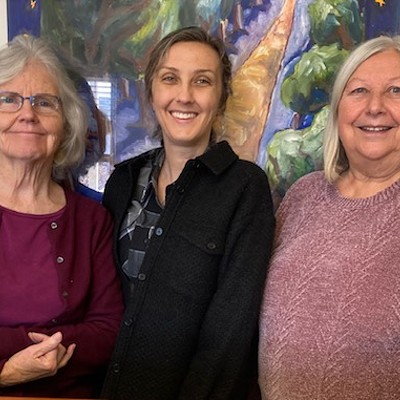
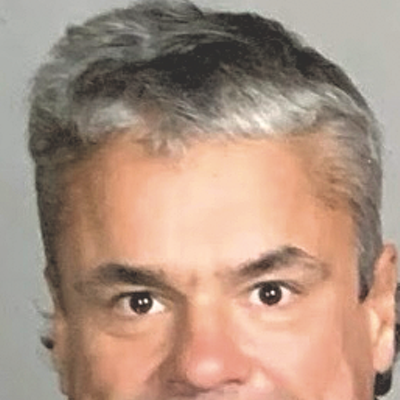
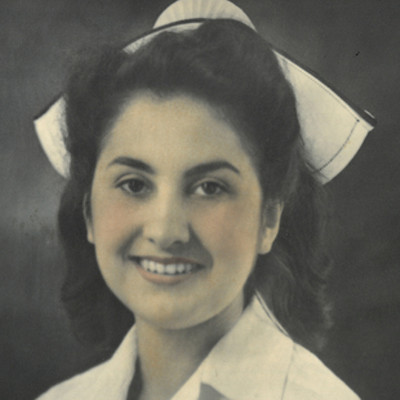
Comments
Comments are closed.
From 2014-2020, Seven Days allowed readers to comment on all stories posted on our website. While we've appreciated the suggestions and insights, right now Seven Days is prioritizing our core mission — producing high-quality, responsible local journalism — over moderating online debates between readers.
To criticize, correct or praise our reporting, please send us a letter to the editor or send us a tip. We’ll check it out and report the results.
Online comments may return when we have better tech tools for managing them. Thanks for reading.